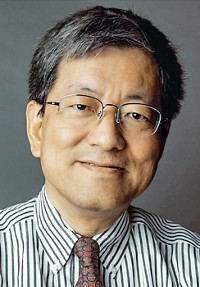Advertisement
Grab your lab coat. Let's get started
Welcome!
Welcome!
Create an account below to get 6 C&EN articles per month, receive newsletters and more - all free.
It seems this is your first time logging in online. Please enter the following information to continue.
As an ACS member you automatically get access to this site. All we need is few more details to create your reading experience.
Not you? Sign in with a different account.
Not you? Sign in with a different account.
ERROR 1
ERROR 1
ERROR 2
ERROR 2
ERROR 2
ERROR 2
ERROR 2
Password and Confirm password must match.
If you have an ACS member number, please enter it here so we can link this account to your membership. (optional)
ERROR 2
ACS values your privacy. By submitting your information, you are gaining access to C&EN and subscribing to our weekly newsletter. We use the information you provide to make your reading experience better, and we will never sell your data to third party members.
People
ACS Award In Inorganic Chemistry
by Jessica Morrison
January 5, 2015
| A version of this story appeared in
Volume 93, Issue 1
Sponsored by Aldrich Chemical Co. LLC
The deep blue color of copper salt transfixed a young John T. Groves and activated his interest in studying the oxidation reactions that would come to define his career. He thought first of investigating iron oxidation reactions catalyzed by enzymes, a process valuable to the field of drug discovery, but Groves found himself mystified by seemingly simple, yet unpredictable, inorganic oxidation reactions catalyzed with metal ions.
“I was always taken with the precision with which organic chemists push arrows in their mechanisms,” says Groves, a professor of chemistry at Princeton University. “If I was going to understand these proteins that catalyze oxidations with iron, I needed to know more about how simple nonenzymatic complexes worked.”
Regarded now as one of the founders of bioinorganic chemistry, Groves turned his fascination with inorganic metal catalysts and his inclination for biological mechanisms into an entirely new field of study. His broad research career bridges the fundamental principles of inorganic chemistry with applied catalysis and functional bioinorganic chemistry, colleagues say.
“The discoveries that he made are the foundation for what so many people do,” says Paul Chirik, a professor of chemistry at Princeton and the newly appointed editor-in-chief of the ACS journal Organometallics. Groves’s groundbreaking proposal of the rebound mechanism in enzymatic C–H bond hydroxylation has withstood scrutiny for nearly four decades, Chirik adds. Groves’s trailblazing 1979 hydroxylation paper published in the Journal of the American Chemical Society has been cited more than 700 times (DOI: 10.1021/ja00498a040).
His recent work takes an imaginative leap forward to demonstrate manganese-catalyzed C–H fluorination. This is something that nature doesn’t do, Groves says. In his role as a chemist, he gets to study nature and “imagine what it hasn’t gotten around to doing yet.”
Groves received a bachelor’s degree at Massachusetts Institute of Technology in 1965 and a Ph.D. from Columbia University in 1969. He then joined the chemistry faculty of the University of Michigan as an assistant professor, earning tenure and full professorship during the ensuing decade. In 1985, Groves moved to the chemistry department of Princeton University. He was chair of the department from 1988 to 1993 and has held the Hugh Stott Taylor Chair of Chemistry since 1991.
He is a member of the National Academy of Sciences; a fellow of the Royal Society of Chemistry, the American Academy of Arts & Sciences, and the American Association for the Advancement of Science; and the cofounder of HepatoChem, a company that provides chemistry-based services used in drug discovery. Groves received the Ira Remsen Award from the Maryland chapter of the American Chemical Society in 2010 in recognition of his career in chemistry teaching and research.
Groves will present his award address before the Division of Inorganic Chemistry.






Join the conversation
Contact the reporter
Submit a Letter to the Editor for publication
Engage with us on Twitter